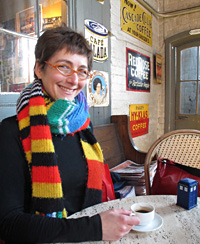A woman came to me after the presentation and asked me why I didn't do a "normal" sock heel. I laughed a little - I knew what she meant. There are lots of heel turns, some newer and some traditional.
The heel turn I use is known variously as a German, Dutch, band or square heel. 'Band' or 'square' are good names for it, as it creates a square under your heel. The thing is, it's not the most common - perhaps not the "normal" one this knitter was used to seeing.
 |
| Band heel - in miniature |
I choose this one for two reasons: it's easy to work, AND it's easy to resize. It's easy to work, in that you're always working the same number of stitches back and forth in the middle, and always placing the decrease in the same place each time. I find that helps me keep track of where I am, and reduces the need to count.
There is another popular heel turn, called the "Half Handkerchief" - chances are you've encountered this one before. It creates a little triangle shape under the back of the heel. It's easily identified by the fact that on each heel turn row, you work one more stitch each time after the decrease. It's always "knit a few stitches, ssk, k1" on the right side, and "purl a few stitches, p2tog, p1" on the wrong side. (There's also a variation called a Round Heel that works the same way - the difference between the two is just how many stitches are in the center at the back, and therefore the shape the results - is it pointier like a folded handkerchief shape, or is it more round.)
 |
| Half handkerchief |
 |
| Round heel |
And these turns are utterly interchangeable. I like mine for the two reasons that I mentioned above, but if you prefer another, you can certainly use that in my patterns.
And indeed, that's what I said to this knitter: if you like a particular heel turn, then it's easily substituted. That's one of the great things about sock knitting: you can combine elements from other patterns.
(There are some limitations, in that both of these heels are flap-and-gusset-heels; if you want to substitute for a short-row or flapless heel, a little bit more work is required, but not a lot.)
And hey, if you like my favourite heel, you can use that in other patterns, too.
*****
Update: Christine asks a sensible question, below...
I've found that they have slightly different shapes. With you saying that they're utterly interchangeable, I assume it's just placebo effect that makes us think that one fits better than the other?Yup, they are different shapes, as per the pictures above. And yup, they do fit a little differently, it's true. But the fit difference - for most people, for most feet - isn't all that noticeable. When I said "interchangeable", I meant that in the patterns you could chose to work one in place of the other, with no larger effect on the pattern. The point is that you can find one you like best - in terms of working and wearing and fit - and use that.










